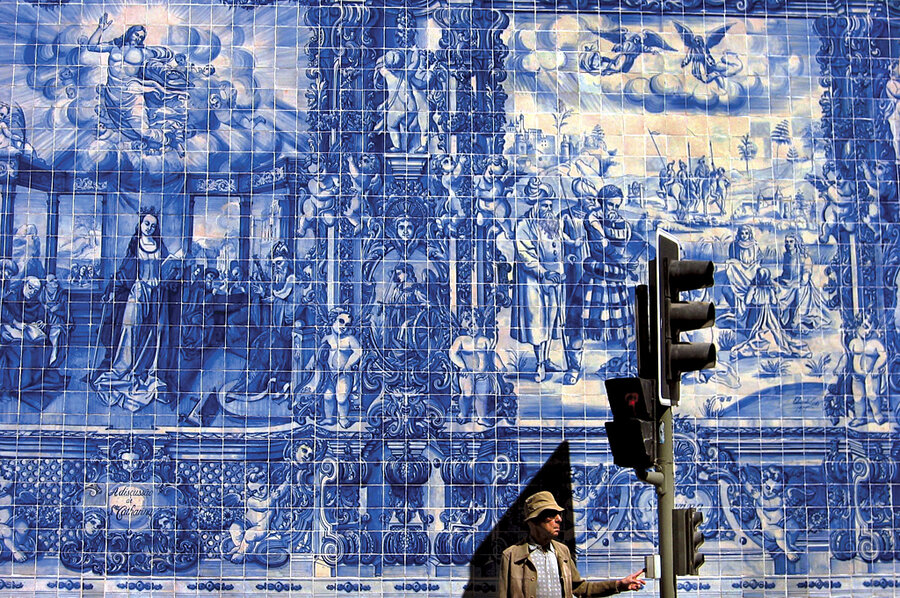Tile hunters
Loading...
The camera doesn't work.
I have finally arrived in Lisbon. This is the Museu Nacional do Azulejo, the National Tile Museum, and I am standing in front of the most beautiful hand-painted tiles in the world.
Soft light falls from the vaulted ceiling onto the large panel. Moving closer, I long to touch this curlicue of cool green copper, that rough line of chocolate manganese, this shiny ridge where cobalt blue meets a deep pool of yellow lead. The guard shifts in his chair and cocks his head in warning. I step back, raise the camera, and shoot: Again, nothing happens.
"I tested it," claims my husband, Rob, as he lifts the camera strap gently from around my neck. He knows what this means to me: I'm a tilemaker, and these 16th-century beauties quiver with life. There is something about the design, the brush strokes, the slight impurities in the glaze: It's a perfect balance of plan and accident. At the moment, nothing else really matters, not even the fact that we are, after all, on our honeymoon.
The road here was long. Having met in recovery – from sad divorces and dead-end day jobs – we vowed to venture outside the lines. Leap day was the perfect wedding date, the start of a lifelong treasure hunt. In Lisbon, we weren't sure what we were looking for, but the search had taken us up the city's steep hills to churches filled with saints and angels on blue-and-white tile.
At Solar, an antique shop in Barrio Alto, the tiles were so expensive we could buy only one. Our fantasy of discovering wizened craftsmen practicing the art in the old way led us to the outskirts of the city during the worst rain in 40 years. The cabdriver gunned the car across a toppled chain-link fence to a certain studio, but the murals the artist unveiled would have looked better on velvet. Finally, after standing in the median of a six-lane road shouting "Madre de Deus?" at every bus that stopped, we found the convent that houses this museum.
But the camera isn't working. After interminable fiddling and clicking, Rob sighs and puts it away. "Stay here and sketch," he says. "I'll be back."
Miserable, I take notes and draw for three long hours. When he returns, oddly smug, with the still-broken camera, he ushers me onto a bus and, while holding on to a strap, tells me about a tiny restaurant he found in the tangle of narrow streets called the Alfama, the original Moorish quarter of Lisbon. After dining on fish and pastries, Rob had successfully tested his theory that Portuguese is merely Spanish with a lisp and he emerged with an address scribbled on the back of a receipt.
After getting off the bus, we pass a dozen dark shops before entering one jumbled with furniture – carved chests, turned legs, dust-caked mantelpieces – heaved to the ceiling as if by an earthquake. The roof is dripping, and all along one wall, a teetering stack of mildewed toilets collect rainwater.
A hulking man in a blue smock shuffles out of the gloom and heads toward an enormous old door at the end of the corridor. I hesitate, a little afraid, until Rob takes my elbow and steers me into a muddy courtyard filled with garbage and cats. There is a crude lean-to in one corner, and it takes a moment to realize that someone is living there.
Among the plastic dishes of spoiled food strewn over the ground, something catches my eye, something blue and white. I lean down to pry it from the muck, wipe it on my jeans, and inspect it closely: It's a hand-built, hand-painted tile that is probably 200 years old. The artistry is delicate and skilled. Once part of a mural, it features a pomegranate, split to reveal the juicy seeds inside. In one spot, the underglaze has effervesced – a happy accident – to form a delicate spray of bubbles along the torn edge of the fruit.
"Look around," says Rob, his arms wide. In the mud, under the trash, lie hundreds of them, each one different, perfect, and covered in green slime.
"How much?" I ask. The man names a price that is something from a dream.
Would real treasure seekers sweat hailing a cab with a load of reeking wet boxes, procuring bales of bubble wrap, slogging through security? Of course not.
I smile at my husband. "Tell him we'll take them all."





